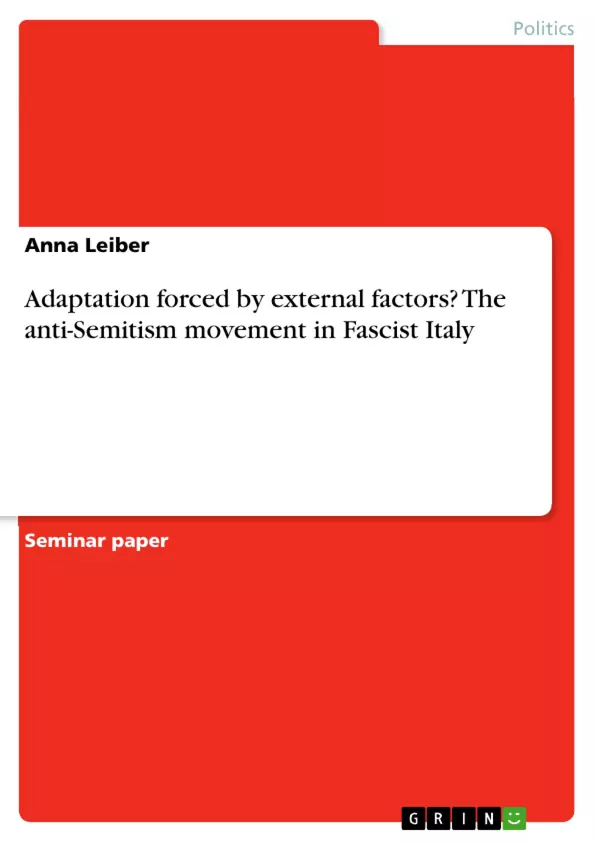During the last 25 years, starting from the fiftieth anniversary of the anti-Jewish laws in Fascist Italy, there has been an increasing interest in the Italian history at the beginning of the twentieth century. Many political and historical scientists thereby focussed on one main question: What developments led to the enormous radicalization policy and the progressive anti-Jewish movement under Mussolini? As it will be outlined in this paper, Italian researchers gave an answer to this by primarily analyzing the national history, whereas political scientists and historians from Germany, England, and the United States based their studies on a comparison between the situation in Fascist Italy and Nazi Germany. The Italian system, in opposite to the regime in Germany, turned radically against the Jews not until 1938, after a long period of political acceptance. Due to the suddenness of this attitude change, researchers saw the developments in Italy as a result of bilateral dependencies and continuous force coming from Germany. As the following comparison will underline, however, the Italian anti-Semitism movement arose from internal, historically constituted factors, and it shows evident differences to the developments in Germany. This paper looks in detail at the period between 1933-1945 in both political systems, as the most decisive decisions were taken within those years.
Inhaltsverzeichnis (Table of Contents)
- Summary
- Introduction
- Research Background
- Analysis: The Developments in Fascist Italy and Nazi Germany between 1933 and 1945
- Conclusion
Zielsetzung und Themenschwerpunkte (Objectives and Key Themes)
This paper aims to analyze the developments in Fascist Italy and Nazi Germany between 1933-1945, specifically focusing on the rise of anti-Semitism in both regimes. It aims to address the question of whether Mussolini's political change was influenced by Hitler or not. By comparing the legislative measurements taken in both countries during the 1930s and 1940s, the paper seeks to contribute to the ongoing debate on the alliance between these regimes and its consequences for the radicalized anti-Semitic movement in Europe.
- The rise of Fascism in Europe after World War I
- The differences between the Italian and German Fascist movements
- The development of anti-Semitism in both Italy and Germany
- The impact of the German regime on the Italian Fascist government
- The influence of internal factors on the Italian anti-Semitism movement
Zusammenfassung der Kapitel (Chapter Summaries)
- Summary: This chapter provides a brief overview of the paper's objectives and key themes. It highlights the growing interest in the history of Fascist Italy and the question of what led to the radicalization policy and anti-Jewish movement under Mussolini.
- Introduction: This chapter discusses the emergence of Fascism in Europe after World War I and its significance in the context of a disastrous national situation. It explores the difficulties in defining Fascism and emphasizes the importance of considering national historical influences. The chapter then focuses on the specific case of Italy and Germany as the most important Fascist nations during the interwar period, providing a definition of Fascism as a system of political authority and social order aimed at reinforcing unity, energy, and purity. It concludes by highlighting the lack of correlation between the political aspirations of early Italian Fascism and the persecution of the Jewish population.
- Research Background: This chapter delves into the contradictory answers given by scholars regarding the influence of Hitler on Mussolini's political change. It outlines the contrasting perspectives on the relationship between the two regimes and the factors that contributed to the Italian anti-Semitic movement.
Schlüsselwörter (Keywords)
The paper focuses on the rise of Fascism in Italy and Germany, the development of anti-Semitism in both countries, the relationship between the two regimes, and the influence of internal and external factors on the radicalization of anti-Semitic policies. Key concepts include Fascism, anti-Semitism, national unity, political persecution, historical influences, and comparative analysis.
- Citation du texte
- B.A. Anna Leiber (Auteur), 2014, Adaptation forced by external factors? The anti-Semitism movement in Fascist Italy, Munich, GRIN Verlag, https://www.grin.com/document/282697



